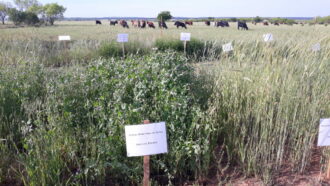SAN ANGELO, Texas – Farmers in west Texas are eyeing legume cover crops as a nitrogen and forage source to fill fallow periods between dryland, no-till wheat and cotton crop rotations.
But finding the best fit for the area’s environmental challenges is proving tricky. So Texas A&M University researchers are working with farmers to develop best management practices ranging from best species mixes to ideal seeding rates to termination times.
“Farmers generally do not have a legume in their crop rotation at all in this area. Legume cover crops have the potential to offset nitrogen fertilizer inputs and provide a high-value forage source for livestock,” said Reagan Noland, Texas A&M AgriLife Extension agronomist.
Noland works out of the Texas A&M AgriLife Research and Extension Center in San Angelo, the seat of Concho Valley agriculture dominated by both crop (cotton and wheat) and animal (goat, sheep and cattle) industries. So incorporating cover crops on the farm made sense to the agronomist and his colleagues.
“Cover crops also have the potential to improve the health of soils. In our part of the world, drought and wind are common and are a problem, but when it does rain, soils are just as susceptible to erosion and water issues,” said Noland. “So keeping something on that soil is important, especially if it can serve as a dual-use-crop.”
Through multiple Southern Sustainable Agriculture Research and Education (SSARE) On-Farm Research grants, Noland worked with farmers in Concho Valley to conduct warm-season legume trials (cowpea and sunn hemp) following grain sorghum and wheat harvests, and cool-season legume trials (hairy vetch, Austrian winter pea, and sweetclover) following grain sorghum and cotton harvests. The researchers grew the legume cover crops with common grass crops cereal rye and pearl millet to study the biomass production, soil benefits and potential forage.
Key findings indicated that inclusion of a grass species enhanced overall biomass production across systems, and reduced weeds in warm-season cover crops. Key annual legume species identified as best adapted to the region were Austrian winter pea (cool season) and sunn hemp and cow pea (warm season). But there are best management practices that farmers need to consider, said Noland.
“Warm-season legume trials did not yield adequate growth for measurement. The originally planned window for this warm-season cover crop option (following wheat or grain sorghum harvest) has proven to be generally unsuitable to this region. Due to lack of rain, the legumes were not established until late-August or early-September,” said Noland. “Due to their photoperiod sensitive reproductive physiology, the summer legumes began flowering and ceased vegetative growth shortly after establishment.”
Noland indicated that it may be difficult to incorporate warm-season cover crops, like sunn hemp or cowpea, in existing cotton, wheat or sorghum rotations due to a late planting date and managing seeding rates relative to weeds and the inclusion of a grass species.
“The best opportunity to use this group of crops is likely with spring planting,” said Noland. “The potential is there for farmers to grow these species as an alternative forage, planted and managed similar to other warm-season annual forage and hay crops.”
The establishment of cool-season legumes was more successful, but both establishment and total biomass were influenced by species, as well as the inclusion of a grass cover crop.
“Inclusion of rye increased total cover crop biomass by 150 percent, and decreased legume establishment by 25 percent. Overall findings demonstrate the value of including rye to supplement biomass production and sequester more nitrogen,” said Noland. “However, the study also found that rye competes with other species in the mixture, highlighting the importance of maintaining a lower seeding rate.”
Researchers found that Austrian winter pea tends to complement rye well in achieving the greatest biomass at the lowest seeding rates.
“This supports the potential to reduce seeding rates and leverage these species’ capacity for compensatory growth, minimizing the economic risk associated with planting cover crops in a marginal environment,” said Noland. “However, more data needs to be collected to develop confident seeding rate recommendations for this area.”
Noland said that there is no easy solution to integrating legume cover crops in the west Texas environment, but the data gathered from the studies is providing farmers with other crop production options.
“Most of the cotton in west Texas failed in 2022 due to lack of rain,” said Noland. “Several growers saw this as an opportunity to try a cover crop, and many reached out to our program for insight.”
The project provided a first look at how legume cover crops might function in crop rotations in west Texas.
“If a farmer wants to try a cover crop in this environment, I emphasize keeping their options simple and risk low. Wheat or rye are very functional for soil security and biomass production. For a legume, I’d pick Austrian winter pea. It’s well-adapted, productive and easy to terminate,” said Noland. “Those are good options to start out with. We also need to be reasonable with our expectations and focus on optimizing value. In our often-marginal environment, cover crops can be difficult to justify based on one benefit alone, such as legume nitrogen credit. That’s why we get excited about opportunities to graze.”
